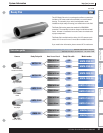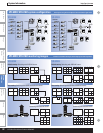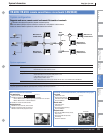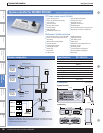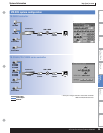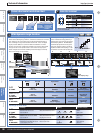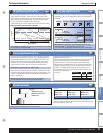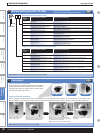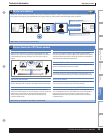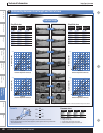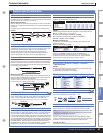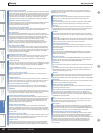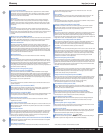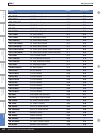
A
B
C
D
E
F
G
H
I
J
amount of light with which it is possible to perform the reproduction of images without
clipping even when more light comes in than the amount stated above. In general, this is
expressed in dB, % and times.
Electronic sensitivity up
This is a function used to increase sensitivity by lengthening image device storage time
beyond the norm or adding image signals to image memory via frames or field units.
Electronic zoom
This is a function that employs the scanning variable of an image device or image memory
rather than an optic lens to electronically enlarge or shrink the image on the screen.
Ethernet
This is the LAN standard devised by Xerox Corporation, DEC Corporation (currently a branch
of Compaq Computer Corporation) and Intel Corporation, and has been standardized by the
IEEE 802.3. CSMA/CD has been adopted for data transmission over networks.
Firewall
This is a software system that is used to prevent unauthorized entry into an organization's
computer network from the outside. It also refers to computers with built-in firewall systems.
Frame rate
This rate is established by JVC IP Products and refers to the number of frames transmitted per
second for JPEG and MPEG-4 images. The maximum frame rate is fixed for each image size
depending on the specifications of the respective JVC IP Products models.
File transfer protocol (FTP)
This is one of the communications protocols used when exchanging files over the Internet.
FTP is employed as the standard Internet file transfer method. Selecting FTP can often save
time when downloading.
FTP client function
This is a JVC IP Products (VN-C655U(B)/C625U/C205U/C20U/E4U) function that makes it
possible to periodically (range of values: 0 to 86,400 seconds) upload images (JPEG still
images only) to any FTP server.
FTP server function
This refers to the JVC IP Products (VN-C655U(B)/C625U/C205U) user page storage function.
By utilizing any FTP client software program, HTML or JPEG image signals independently
created by the user can be uploaded to VN-C655U(B)/C625U/C205U.
Full duplex
This is a transmission method by which it is possible to send and receive data simultaneously.
F number
This is a number that represents lens brightness; the smaller number, the brighter lens. The
relationship between brightness (F number), focal length (fl) and effective diameter (D) is
described by the following equation: F = fl/D.
Genlock
This is a type of external sync system with a function that synchronizes external sync signals
with frequency and phase. There are three types of genlock input signals: composite sync
signals (composite SYNC), composite video signals (VBS or VS) and black burst signals (BBS).
Half duplex
This is a transmission method by which data cannot be sent and received simultaneously, but
rather can only be transmitted in one direction at a time.
Hyper text transfer protocol (HTTP)
This is a protocol used by World wide web (WWW) servers and web browsers for sending
and receiving information such as files.
The institute of electrical and electronics engineers 1394 (IEEE1394)
This is a next-generation, high-speed SCSI standard used to connect computers with
peripherals and other devices. Both daisy-chain connections of up to 63 devices and tree
connections are made possible by this protocol. The transfer speeds of 100 Mbps, 200 Mbps
and 400 Mbps have been standardized.
Iris
The iris controls the amount of light taken in by the lens when changes in illumination occur.
A manual iris lens is used when luminance is fixed, and an auto iris lens is used in cases
when luminance changes according to the time of day.
Java applet
This is a small program that is distributed from a WWW server to a web browser (client) and
then executed by the Web browser. It is used for the purpose of adding movement to the
screen. When viewing the image of JVC IP Products (VN-C655U(B)/C625U/C205U/C20U/E4U)
on Internet Explorer or Netscape, this program is utilized to display moving images.
Joint photographic coding experts group (JPEG)
This is a standard established by ITU-TS (International Telecommunication Union: formerly
known as CCITT) and ISO (International Organization for Standardization) that decides the
compression and expansion of color still images. This technology makes it possible to
compress still images from a scale of 1/10 to 1/100. Although one of the disadvantages of this
is that both compression and distribution are time consuming, compressibility can be
modified; this means that by altering the degree of deterioration in image quality during
compression it becomes possible to choose from among image quality, file size and
processing time.
Automatic gain control (AGC)
Using a circuit built into the camera, gain control makes it possible to automatically maintain a
constant output signal level even if there are changes in brightness. This makes it possible to
obtain a picture with the same level of brightness regardless of whether it is taken in a dark or
bright place. (Noise may slightly stand out.) When a strong signal exceeding the set level is
input, signal saturation is prevented by controlling gain. In the event that a weak signal is
input, the signal is raised to correspond with the set level and this fixed level is maintained.
Application program interface (API)
This refers to the instruction and function sets that can be utilized when developing software
as well as the established rule set for the program procedures that are necessary for
employing these instruction and function sets.
Automatic electronic shutter (AES)
This is a function that automatically controls the device output level according to the incident
light amount by utilizing the electronic shutter function of a solid-state image device.
Auto negotiation
Auto negotiation is regulated by IEEE 802.3u. This function can be used to determine the
appropriate transmission system for the corresponding device (Hub etc.) as well as select the
optimum (highest possible speed) transmission method prior to transmission. When the
corresponding device supports two or more of the transmission systems as well as the auto
negotiation function, the high-priority items (fast transmission speed etc.) are given
precedence. In the event that the corresponding device does not support the auto
negotiation function, the transmission speed is automatically selected, but the automatic
selection of full-duplex/half-duplex is not performed and half-duplex is always chosen.
Auto white balance (AWB)
When using CCD or film, pictures often come out reddish or greenish (orangish or bluish) in
color when taken under incandescent or fluorescent light. AWB makes it possible to adjust
white color balance under a wide variety of light sources. Automatic tracking (tracing) white
balance (ATW), automatic white balance (AWB), automatic white balance control (AWC),
manual mode and other features are available.
Backlight compensation (BLC)
With backlight scene, the auto iris function responds to the bright portion of the screen, thus
causing the iris to narrow and resulting in the "darkening of the subject" phenomenon.
Backlight compensation is a function that can be utilized to correct this phenomenon.
Category 5 (Cat 5)
This refers to the quality assurance of connection parts such as unshielded twisted pair (UTP)
cables and connectors. With LAN, category 3 is primarily utilized. For 100 BASE-TX, category
5 and above are used, and category 5e and above are required for 1,000 BASE-T.
Charge coupled device (CCD)
A charge coupled device is a semiconductor device that converts images to electrical
signals.
Closed circuit television (CCTV)
Refers to a system of cameras and video accessory devices over a internal cabling path.
Differs from broadcast video.
Compact flash (CF)
This is the standard for memory cards advocated by San Disk Corporation, and is utilized as a
storage device for digital cameras etc. Compact flash combines flash memory that does not
go off even when the power is turned off and an I/O controller circuit on just one card.
Common intermediate format (CIF)
This is the universal video signal format regulated by ITU-T H.261. CIF supports moving
images with a data rate of up to 30 frames per second and a resolution of 352 x 288 pixels.
CSMA/CD
This is an access control method utilized for ethernet transmissions. When collisions occur
due to multiple terminals attempting to simultaneously make transmissions, the transmissions
are stopped and then resumed after an appropriate amount of time has passed.
Dynamic host configuration protocol (DHCP)
This protocol is employed to automatically allocate IP addresses to clients when they turn on
their PCs and then retrieve these addresses from them when they switch off their computers.
On the server side, it is only necessary to collectively prepare several DHCP-client-use IP
addresses. It is also possible to simultaneously provide clients with information such as
gateway addresses, domain names and subnet masks.
Domain name system (DNS)
This system is used to replace IP addresses, which are expressed on the Internet with
numerals (e.g. 255.254.253.0), with domain names that are easy to remember. On the internet,
there are servers referred to as DNS servers that have IP address and domain name tables.
By connecting to DNS servers, users can access the server that possesses the IP address via
the domain name.
Digital signal processor (DSP)
This processor converts the input analog signal to a digital signal and then performs a variety
of signal processing tasks. Thus, unlike analog processing, it is possible to produce stable
and clear images without signal degradation within the circuit.
Dynamic range
This refers to the range within which the reproduction of images can be performed without
adversely affecting gradation. The amount of light necessary for the luminance signal to
reach the white peak at 100 IRE (100 % video level) is defined as 1, and this is the ratio of the
42
Glossary
JVC Video Surveillance Products 2006-2007
http://pro.jvc.com
Line-up Chart Color Camera Storage Flat Panel Display
& Monitor
IP Security
Products
System
Information
Technical
Information
Glossary Index



